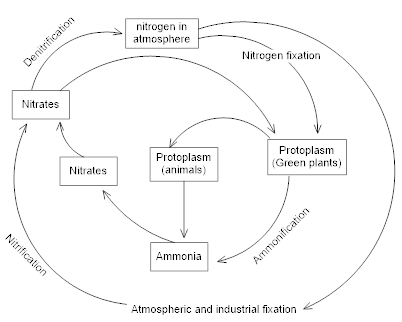Revision Notes - Test Papers
CBSE Test Paper 01
Chapter 14 Natural Resources
Biosphere occurs _____ (1)
- Place of interaction of lithosphere, hydrosphere and atmosphere
- In atmosphere and hydrosphere.
- In lithosphere
- Place of interaction of lithosphere and hydrosphere
Match the following with correct response. (1)
(1) Smog (A) Producers (2) Biotic components (B) Coal (3) Protective blanket (C) Ozone layer (4) Fossil fuel (D) Smoke and fog - 1-C, 2-B, 3-D, 4-A
- 1-D, 2-A, 3-C, 4-B
- 1-A, 2-C, 3-B, 4-D
- 1-B, 2-D, 3-A, 4-C
Percentage composition of in air is:- (1)
- 12.5%
- 52%
- 21%
- 78%
______ covers whole of the earth like a blanket. (1)
- Lithosphere
- Troposphere
- Atmosphere
- Hydrosphere
In nutrient cycle, minerals tend to be dispersed through (1)
- convection
- evaporation
- surface and sub-surface run off
- assimilation
What is the major source of fresh water in the city/town/village where you live? (1)
Why step farming is common in hills? (1)
What are the two main causes of over-exploitation of natural resources? (1)
Define soil erosion. (1)
Which gas is added to the atmosphere by the decay of organic matter? (1)
When we breathe in air, nitrogen also goes inside along with oxygen. What is the fate of this nitrogen? (3)
Why is the air near the busy roads more polluted than air at a distance from the busy roads? (3)
What is atmosphere? What are its different regions? (3)
Discuss the nitrogen cycle in nature? (5)
- What are the sources of oxygen in the atmosphere? (5)
CBSE Test Paper 01
Chapter 14 Natural Resources
Answers
- Place of interaction of lithosphere, hydrosphere and atmosphere
Explanation: The whole combination of animals, plants and non-living beings which by their interaction make the planet earth a live and vibrant place is called biosphere.
- Place of interaction of lithosphere, hydrosphere and atmosphere
- 1-D, 2-A, 3-C, 4-B
Explanation:- Smog is a mixture of fog and smoke. Formation of smog is a visible indication of air pollution.
- Living things constitute the biotic component of the biosphere. Means producers are Biotic components .
- The ozone layer or ozone shield is a region of earth's stratosphere that absorbs most of the Sun's ultraviolet (UV) radiation. So, ozone layer act as protective blanket.
- Coal, petrol are fossil fuel.
- 1-D, 2-A, 3-C, 4-B
- 21%
Explanation: 21% oxygen
78% nitrogen
0.002% carbon dioxide
And traces of helium, argon, neon etc are present in the atmosphere
- 21%
- Atmosphere
Explanation: The multilayered gaseous envelope surrounding the planet earth is called atmosphere. Atmosphere covers the Earth, like a blanket.
- Atmosphere
- surface and sub-surface run off
Explanation: The nutrient cycle describes the use, movement, and recycling of nutrients in the environment. In nutrient cycles in general, minerals tend to be dispersed through surface and subsurface runoff.
- surface and sub-surface run off
In city/town/village, the major source of water is underground water. It is drawn with the help of hand pumps and tube-wells. The other nearby sources are rivers, lakes and ponds.
Step farming is practised in hills to check soil erosion through water currents on the slopes.
Growing population and industrialisation.
Soil erosion is the removal of fertile top soil by the agency of wind or water.
Carbon dioxide
The nitrogen inhaled during respiration is not used in the body and it comes out with CO2 during exhalation. Air we breathe in comprises of 78% of Nitrogen, 21 % of Oxygen, 0.03% of Carbon dioxide, and remaining % is the other gases. As we know, oxygen is the important gas which helps in conversion of our food into energy.
Nitrogen is very essential in diluting the oxygen to make it available to all the cells. Water vapour in air is also important to body. Remaining nitrogen is exhaled out (74%of Nitrogen). Other gases are also exhaled out in negligible amounts.Burning of gasoline in power cars and trucks gives out particulate carbon, and carbon dioxide, carbon monoxide, hydrocarbons, oxides of nitrogen and sulphur. Emissions released directly into the atmosphere from the vehicles remain confined in the congested areas near busy roads.
Hence areas far away from these emmusions are cleaner than around traffic areas. Also off traffic have parks and gardens which purify the air. Hence it is advisable to grow trees around roads and streets
The layer of air surrounding the earth is called an atmosphere. The different regions are:-
- Troposphere
- Stratosphere
- Mesosphere
- Thermosphere
The nitrogen cycle in the following steps:-
- Nitrogen in the atmosphere gets converted to protoplasm in green plants by nitrogen fixation.
- The protoplasm gets converted into ammonia by ammonification.
- The ammonia then converts to nitrites and then nitrates.
- Then nitrogen in the atmosphere gets directly converted to nitrates through nitrification.
- The nitrates get converted into nitrogen through denitrification.
Sources of oxygen in the atmosphere:
- Early in the evolution of the Earth, oxygen is believed to have been released from water vapour by ultra-violet radiations and accumulated in the atmosphere as the hydrogen escaped into the outer layer of the Earth's atmosphere.
- The main driving factor of the oxygen cycle is when water and carbon dioxide combine in the presence of sunlight and chlorophyll to form glucose and oxygen by the process of photosynthesis.
- Molecular oxygen is mainly contained in rocks and minerals.
- Molecular oxygen is also released in the atmosphere by the process of photolysis.
- The weathering process initiated by organisms can also free the oxygen from the lithosphere.
- Plants and animals extract nutrient minerals from rocks and release oxygen in the process.

